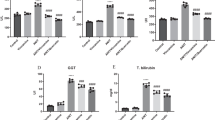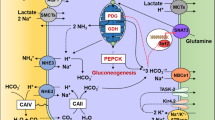Summary
Like other lipid-soluble xenobiotics, clofibrate (ethyl-2-(4-chlorophenoxy)-2-methylpropanoate) increased the level of microsomal cytochrome P-450 in liver and decreased the utilization of 14C-orotic acid for the synthesis of hepatic cytidine nucleotides. This phenomenon was associated with the increased (a) uptake of 14C-cytidine, (b) total content of cytidine components of the acid-soluble extract and (c) utilization of this nucleoside for the synthesis of RNA. No changes were observed in uridine components. Clofibrate also increased the level of cytochrome P-450 in kidney microsomes; the degree of induction was almost the same as in the liver. The variations of renal pyrimidine metabolism after administration of the drug were analogous to those observed in the liver.
Similar content being viewed by others
References
Azarnoff DL, Reddy JK, Hignite C, Fitzgerald T (1976) Structure activity relationships of clofibrate-like compounds on lipid metabolism. In: Vapaatalo H, Proceedings 6th International Congress Pharmacology vol 4: Drug Therapy Pergamon Press, Oxford, pp 137–147
Best MM, Duncan CH (1964) Hypolipidemia and hepatomegaly from ethyl-chlorophenoxyisobutyrate (CPIB) in the rat. J Lab Clin Med 64:634–642
Endou H (1983) Cytochrome P-450 monooxygenase system in the rabbit kidney: its intranephron localization and its induction. Jpn J Pharmacol 33:423–433
Gibson GG, Orton TC, Tamburini PP (1982) Cytochrome P-450 induction by clofibrate. Purification and properties of a hepatic cytochrome P-450 relatively specific for the 12- and 11-hydroxylation of dodecanoic acid (lauric acid). Biochem J 203:161–168
Hess R, Stäubli W, Riess W (1965) Nature of the hepatomegalic effect produced by ethyl-chlorophenoxyisobutyrate in the rat. Nature 208:856–858
Kurup RCK, Aithal HN, Ramasarma T (1970) Increase in hepatic mitochondria on administration of ethyl-alpha-p-chlorophenoxyisobutyrate to the rat. Biochem J 116:773–779
Lalwani ND, Fahl WE, Reddy JK (1983) Detection of a nafenopin binding protein in rat liver cytosol associated with the induction of peroxisome proliferation by hypolipidemic compounds. Biochim Biophys Res Commun 116:388–393
Lewis NJ, Witiak DT, Feller DR (1974) Influence of clofibrate (ethyl-4-chlorophenoxyisobutyrate) on the hepatic drug metabolism in male rats. Proc Soc Exp Biol Med 145:281–285
Litterest CL, Mimnaugh EG, Gram TE (1977) Comparative alterations in extrahepatic drug metabolism by factors known to affect hepatic activity. Biochem Pharmacol 26:749–755
Lowry OH, Rosenbrough NJ, Farr AL, Randall RJ (1951) Protein measurement with the Folin phenol reagent. J Biol Chem 193:265–275
Omura T, Sato R (1964) The carbon monooxide-binding pigment of liver microsomes. J Biol Chem 239:2370–2378
Orton TC, Parker GL (1982) The effect of hypolipidemic agents on the hepatic microsomal drug metabolizing enzymes system of the rat. Induction of cytochrome(s) P-450 with specifity toward terminal hydroxylation of lauric acid. Drug Metab Dispos 10:110–115
Parker GL, Orton TC (1980) Induction by oxyisobutyrate of hepatic and kidney microsomal cytochrome P-450 with specifity towards hydroxylation of fatty acids. In: Gustafsson JA, Duke JC, Mode A, Rafter J (eds) Biochemistry biophysics and regulation of cytochrome P-450. Elsevier/North-Holland Biomedical Press, Amsterdam, pp 373–377
Reddy JK, Lalwani ND (1983) Carcinogenesis by hepatic peroxisome proliferators: evaluation of the risk of hypolipidemic drugs and industrial plasticizers to humans. CRC Crit Rev Toxicol 12:1–58
Redy JK, Krishnakantha TP, Rao MS (1975) Microbody (peroxisome) proliferation in mouse kidney induced by methylclofenopate. Virchows Arch [B] Cell Pathol 17:295–301
Rush GF, Maita K, Sleight SD, Hook JB (1983a) Induction of rabbit renal mixed function oxidase by phenobarbital: cell specific ultrastructural changes in the proximal tubule. Proc Soc Exp Biol Med 172:430–439
Rush GF, Wilson DM, Hook JB (1983b) Selective induction and inhibition of renal mixed function oxidases in the rat and rabbit. Fundam Appl Toxicol 3:161–168
Salvador RA, Haber S, Atkins C, Gommi BM, Welch RM (1970) Effect of clofibrate and 1-methyl-4-piperidyl-bis-(p-chlorophenoxy)-acetate on steroid and drug metabolism by rat liver microsomes. Life Sci 9:397–407
Seifert J, Vácha J (1975) Microsomal inducers of drug-metabolizing enzymes suppress cytidine nucletide biosynthesis in rat liver. Arch Biochem Biophys 167:366–370
Seifert J, Vácha J (1976) Cytidine nucleotide biosynthesis and the level of cytochrome P-450 in rat liver microsomes after administration of colchicine. Arch Biochem biophys 172:106–109
Seifert J, Buchar E (1978) Increased transport of (G-14C)cytidine into rat liver after administration of α-hexachlorocyclohexane. Naunyn Schmiedebergs Arch Pharmacol 303:101–105
Seifert J, Mostecká H (1987) Effect of clofibrate on DNA synthesis in rat liver and kidney. Arch Toxicol 60:131–132
Seifert J, Vácha J, Buchar E, Seifertová M (1979) The molecular biology of drug induction: The biosynthesis of pyrimidine nucleotides and nucleic acids after the administration of inducers. In: Estabrook RW, Lindenlaub E (eds) The induction of drug metabolism. Schattauer FK Verlag, Stuttgart New York, pp 81–100
Seifert J, Mostecká H (1988) Effect of nafenopin and clofibrate on uptake and utilization of labeled thymidine for DNA synthesis in rat liver and Carcinogenesis (in press)
Tamburini PP, Masson HA, Bains SK, Makowski RJ, Morris B, Gibson GG (1984) Multiple forms of hepatic cytochrome P-450. Purification, characterization and comparison of novel clofibrate induced isoenzyme with other major forms of cytochrome P-450. Eur J Biochem 139:235–246
Vácha J, Seifert J (1977) Biosynthesis of cytidine nucleotides and level of cytochrome P-450 in rat liver after administration of carbon tetrachloride. Toxicology 8:157–164
Author information
Authors and Affiliations
Additional information
Dedicated to Professor Werner Kunz on the occasion of his 65th birthday
Rights and permissions
About this article
Cite this article
Seifert, J., Machková, Z. Biosynthesis of pyrimidine nucleotides and level of cytochrome P-450 in rat liver and kidney after clofibrate administration (an in vivo study). J Cancer Res Clin Oncol 114, 59–63 (1988). https://doi.org/10.1007/BF00390486
Received:
Accepted:
Issue Date:
DOI: https://doi.org/10.1007/BF00390486




